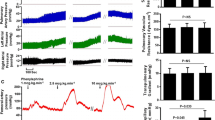We analyzed the contribution of soluble guanylate cyclase-dependent pathway into NO-mediated relaxation of pulmonary arteries under conditions of high pulmonary blood flow modeled by creation of carotid artery-jugular vein shunt in rats. Inhibitor of soluble guanylate cyclase suppressed NO-donor induced relaxation was lower in rats with shunt, but dilatation in response to phosphodiesterase V inhibitor did not differ in the sham-operated and shunt groups. Thus, the structure of NO-mediated vasodilatation of pulmonary arteries under conditions of hypervolemia of pulmonary circulation was shifted to soluble guanylate cyclase-independent pathways, whereas intracellular soluble guanylate cyclase-dependent mechanisms of dilatation were in general unchanged.
Similar content being viewed by others
References
Davydova MP, Postnikov AB, D’iakonov KB, Liubitskiǐ OB, Medvedeva HA. Involvement of tetrahydrobiopterin in local change of endothelium-dependent vasorelaxation in pulmonary hypertension. Ross. Fiziol. Zh. 2003;89(12):1516-1522. Russian.
Davydova MP. The Structure of NO-Mediated Dilatation of Pulmonary Arteries Depends on NO Availability. Bull. Exp. Biol. Med. 2019;167(2):247-249. doi: https://doi.org/10.1007/s10517-019-04501-4
Gorenflo M, Zheng C, Pöge A, Bettendorf M, Werle E, Fiehn W, Ulmer HE. Metabolites of the L-arginine-NO pathway in patients with left-to-right shunt. Clin. Lab. 2001;47(9-10)::441-447.
Lam CF, Peterson TE, Croatt AJ, Nath KA, Katusic ZS. Functional adaptation and remodeling of pulmonary artery in flow-induced pulmonary hypertension. Am. J. Physiol. Heart Circ. Physiol. 2005;289(6):H2334-H2341
Li F, Xia W, Li A, Zhao C, Sun R. Long-term inhibition of Rho kinase with fasudil attenuates high flow induced pulmonary artery remodeling in rats. Pharmacol. Res. 2007;55(1):64-71.
Mistry DK, Garland CJ. Nitric oxide (NO)-induced activation of large conductance Ca2+-dependent K+ channels (BK(Ca)) in smooth muscle cells isolated from the rat mesenteric artery. Br. J. Pharmacol. 1998;124(6):1131-1140.
Yuan XJ, Tod ML, Rubin LJ, Blaustein MP. NO hyperpolarizes pulmonary artery smooth muscle cells and decreases the intracellular Ca2+ concentration by activating voltage-gated K+ channels. Proc. Natl Acad. Sci. USA. 1996;93(19):10 489-10 494.
Zhao YJ, Wang J, Rubin LJ, Yuan XJ. Inhibition of K(V) and K(Ca) channels antagonizes NO-induced relaxation in pulmonary artery. Am. J. Physiol. 1997;272(2, Pt 2):H904-H912.
Author information
Authors and Affiliations
Corresponding author
Additional information
Translated from Byulleten’ Eksperimental’noi Biologii i Meditsiny, Vol. 169, No. 3, pp. 285-288, March, 2020
Rights and permissions
About this article
Cite this article
Davydova, M.P. Modeling of Hypervolemia in Pulmonary Circulation in Rats Changes the Structure of NO-Mediated Relaxation of Pulmonary Arteries. Bull Exp Biol Med 169, 314–317 (2020). https://doi.org/10.1007/s10517-020-04877-8
Received:
Published:
Issue Date:
DOI: https://doi.org/10.1007/s10517-020-04877-8



